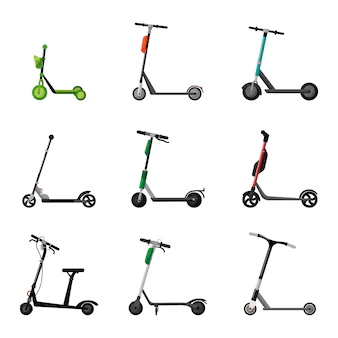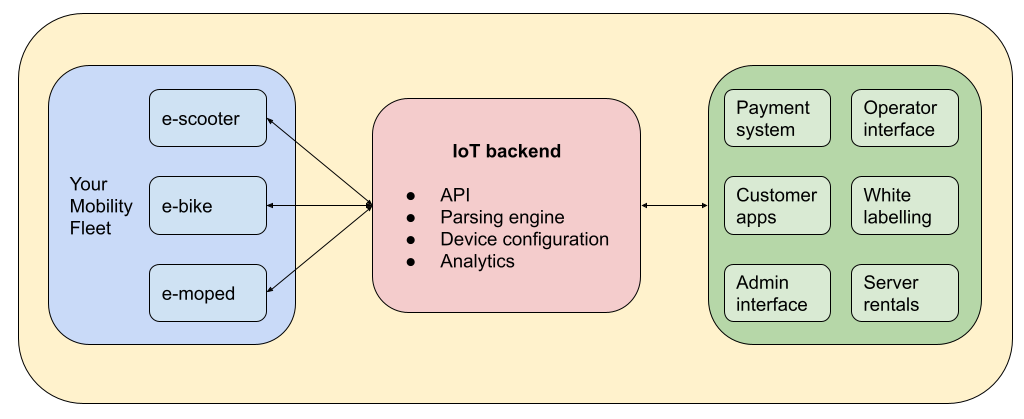A while ago we told you how to arrange reliable two-way communication between your scooter fleet and the software you develop. This time we want to look at a scooter sharing business more broadly, discuss not only technical but also architectural, marketing and administrative aspects, and outline alternatives.
Step 0: Do your home work
Before investing in a scooter sharing venture you want to make sure you understand the local market(s), “see” the demand, understand how to address this demand, and understand how to make your business profitable. There’s a lot of evaluations (both formal and informal) to be done to make a conscious decision to launch the sharing business - market saturation, legal issues, weather restrictions, differentiators, infrastructure readiness, job market, and a lot more. We’ll talk about some of these aspects in the steps that follow.
Step 1: Get support from municipal authorities
Municipalities and national governments take measures to ensure safety for scooter riders, pedestrians, and drivers (speed limits, where electric scooters are allowed to ride, if helmets are required, etc.). Advice: put together a nice ilustrated memo explicitly specifying all applicable regulations — take care of your customers.
Since scooter sharing will operate in a public space and has to accurately integrate into the city infrastructure and local community, the support from the municipal authorities will help your get the official “green light” for your business.
Step 2: Pick reliable scooters
The essence of your business is the fleet you offer and the rental service you provide. Since scooters will represent the major part of your upfront investment, you want to pick them carefully. Obviously, most popular brands originate from China — you simply need to contact them directly, negotiate the terms, order a sample scooter for testing, discuss the possibility of white-labelling, availability of spare parts, warranty, etc.
Tip: Explore the infrastructure in terms of bike lanes and pavements quiality and pick the scooter models accordingly — larger wheels and better shock absoption may improve the customer experience on imperfect surfaces.
One more factor to consider is whether the selected scooter brands and models are supported (or can easily be supported) on the software you are about to use (see Step 3). For instance, the flespi platform has direct contacts with numerous hardware manufacturers such as Teltonika Mobility, Fitrider, Omni, Okai, and others. We will readily introduce you to them once you approach us via email or in the chat.
Step 3: Find the sharing platform provider
What your users will see is just a handy mobile app but there will be an entire software ecosystem servicing it behind the scenes.
Since the core of the sharing business is the scooters, it’s critical to find a suitable telematics platform that will provide high availability service — telemetry data aggregation and analytics, remote scooter management, data storage, etc.
It’s also far-sighted to estimate the scope of supported scooter models and the ease of new models integration. The wider the selection, the less you are restricted in choice and the easier you can go with the new models if at some point they prove to be better.
Another important consideration is how close to a turn-key solution the chosen platform should be — do you only want the backend part where data collection and processing take place, or do you also want a customizable interface, white-labelling, payment system integrations, etc.
In case with a pure backend (e.g. flespi), you get more flexibility in terms of solution architecture, lower price, a wide list of supported hardware, and a straightforward process of new integrations.
In case with a fully-fledged sharing solution (e.g. ScootAPI), you get a comprehensive management platform for managing your e-scooter fleet, whilte-label-ready mobile apps, assistance with payment systems integration, a ready-made administration dashboard, support and consulting from the experts in the field.
It’s important to emphasize the importance of partnerships in todays business environment. In the end, your final solution will include integrations with a payment system, a connectivity provider, datacenter services, and several other parts. These are most often outsourced from a specialized third-party solution providers (e.g. AWS, EMnify, Stripe, etc.).
When evaluating different options to sculpt your solution, please keep in mind that more flexibility gives more control over the end result yet implies more responsibility and requires more developers’ time and efforts. Be sure to find the realistic ratio of your wishes, possibilities, risks, expenses, and profits to lead the project to fruition with maximum probability (and profitability).
Step 4: Hire a dream team
Sharing business is not a one-man journey. There’s a great number of day-to-day routines as well as administrative challenges to address. If you decide to be a swiss-knife specialist, you will most likely end up being a master of none. So, it would be a wise strategic decision to join forces with a few enthusiastic individuals to distribute the duties and deliver better service.
The key roles to add to your team are:
a technician — to service your fleet (as your fleet grows you will need more of these)
a security guy — to deal with thefts and vandalism
a marketer — to promote your business
an administrator — to control the business in real-time
a call-center operator — to help clients
a product manager — to orchestrate the entire team and do complex tasks.
Remember that if you intend to develop your custom solution yourself (taking some IoT backend as a basis), you will also need developers or a subcontractor to delegate these works to.
Step 5: Create a go-to-market strategy
Scooter sharing market is booming, so it’s critical to find the right spot for your business. There’s a lot of work to undertake to differentiate your sharing service from the competition — you will have to articulate your benefits, design a strong brand identity, devise a compelling pricing policy, and promote your business heavily. There are dozens of ways to attract customers — word of mouth, collaborations, traditional ads, Google Ads, social media, sponsored events, content marketing, etc. — you have to make your own mix and go with it.
Hint: competition is not just other scooter sharing businesses, but also public transport, taxi, Uber, bikes, own cars, etc. Talk to locals, learn the “habits” of the community, explore demand in different districts of the city, analyze the quality of infrastructure.
As well as with technology partners, you will most likely rely on third-party services (ad agencies, design bureaus, copywriters, etc.), so building trustworthy long-term relationships is also critical.
***
Sharing business is nothing short of a real business, and, accounting for the competitive landscape, it requires dedication and focused effort of a team of professionals. Even in an uncertain and unpredictable world of today having a clear view of where you are heading and an elaborate plan of action (along with the alternative plans B, C, etc.) is a must. And since no business is a thing-in-itself, nurturing relationships with partners, customers, municipalities, investors, etc. is a top priority.
We hope that this guide was helpful in clarifying the core aspects of building a successful sharing business. If you are excited and inspired to contribute to expanding green micromobility initiatives, you now have the steps to follow for a more efficient start.





